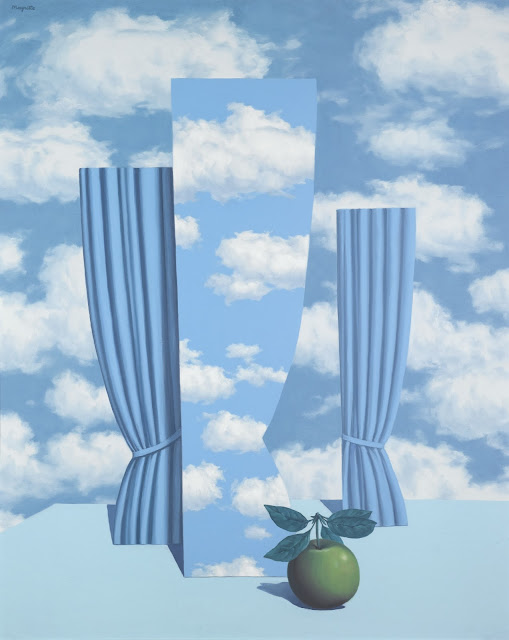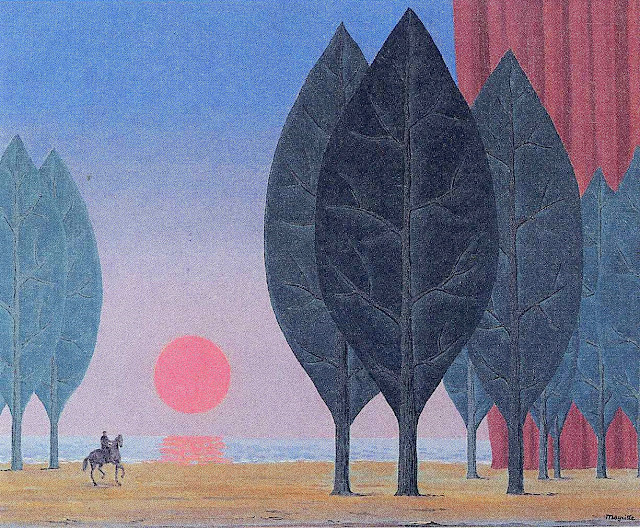For the next few years he was active in the Belgian Surrealist movement.
With the support of a Brussels art gallery, he became a full-time painter in 1926.
His first solo show was held in 1927.
It was not well received by the art critics of the day. That same year he and his wife moved to a suburb of Paris.
There he met and befriended several of the Paris Surrealists, including poets André Breton and Paul Éluard, and he became familiar with the collages of Max Ernst.
In 1930
Magritte🎨 returned to Brussels, where (
except for the occasional journey) he remained for the rest of his life.
During the 1940s he experimented with a variety of styles, sometimes, for example, incorporating elements of impressionism, but the paintings he produced in this period were not successful by most accounts, and he eventually abandoned the experimental.
For the rest of his life he continued to produce his enigmatic and illogical images in a readily identifiable style.
In his last year he supervised the construction of eight bronze sculptures derived from images in his paintings.
The sea and wide skies, which were enthusiasms of his childhood, figure strongly in his paintings. In Threatening Weather (1928) the clouds have the shapes of a torso, a tuba, and a chair. In The Castle of the Pyrenees (1959) a huge stone topped by a small castle floats above the sea. Other representative fancies were a fish with human legs, a man with a bird cage for a torso, and a gentleman leaning over a wall beside his pet lion.
Dislocations of space, time, and scale were common elements. In Time Transfixed (1939), for example, a steaming locomotive is suspended from the centre of a mantelpiece in a middle-class sitting room, looking as if it had just emerged from a tunnel. In Golconda (1953) bourgeois, bowler-hatted men fall like rain toward a street lined with houses.
Two museums in Brussels celebrate Magritte: the René Magritte Museum, largely a biographical museum, is located in the house occupied by the artist and his wife between 1930-1954; and a new Magritte Museum, featuring some 250 of the artist’s works, opened in 2009 at the Royal Museum of Fine Arts. | © Encyclopædia Britannica, Inc.
René Magritte*, pittore Belga, nato a Lessines il 21 novembre 1898, morto a Bruxelles il 15 agosto 1967.
Nel 1913, in seguito al suicidio della madre, si trasferì con la famiglia a Charleroi, dove seguì i corsi dell'Athénée (1913-15) e dipinse le sue prime tele d'impronta impressionista. Stabilitosi a Bruxelles, tra il 1916-1920 frequentò saltuariamente l'Académie des Beaux-Arts (Portrait, 1919; Le portrait de Pierre Bourgeois, 1920, Charleroi, Musée des Beaux-Arts) ed entrò in contatto con V. Sevranckx e P.-L. Flouquet con il quale, nel 1919, collaborò alla rivista Au Volant di P. Bourgeois.
Nel 1920, dopo un breve viaggio a Parigi, Magritte fu costretto, per vivere, ad affiancare all'attività pittorica quella di grafico e di disegnatore pubblicitario. Furono anni d'intensa elaborazione teorica e formale durante i quali Magritte affrontò le problematiche emerse dalle esperienze futuriste e cubiste (L'homme à la fenêtre, 1920; Baigneuse, 1925, Charleroi, Musée des Beaux-Arts); con Sevranckx scrisse, a compendio delle comuni ricerche svolte tra il 1919 e il 1923, il saggio rimasto inedito L'art pur. Défense de l'Esthétique, che presenta notevoli agganci con la poetica dell'Esprit Nouveau.
Scrittore asistematico ma fecondo, nel 1924 pubblicò i suoi Aphorismes sulla rivista 391 di F. Picabia e, tra il 1925-1926, collaborò con E.L.T. Mesens alle riviste d'ispirazione dadaista Oesophage (numero unico) e Marie; in quegli stessi anni conobbe Magritte Lecomte, che lo introdusse alla poesia surrealista e all'opera di De Chirico. Fortemente attratto dalle nuove suggestioni metafisiche, nella seconda metà degli anni Venti Magritte abbandonò l'astrattismo formale, orientandosi verso nuove soluzioni surrealiste e proponendo, con estrema fedeltà oggettiva, immagini del mondo reale associate in imprevedibili combinazioni capaci di produrre atmosfere magiche ed enigmatiche (Le jockey perdu, 1926, coll. priv.; Le mariage de minuit, 1926, Bruxelles, Musées Royaux des Beaux-Arts).



Nel 1927, dopo un'ampia mostra personale organizzata dalla galleria Centaure di Bruxelles, Magritte si stabilì a Parigi dove, in contatto con A. Breton, P. Eluard e J. Miró, aderì al gruppo surrealista parigino e partecipò, nel 1928, all'importante Exposition Surréaliste presso la galleria di C. Goemans; nel 1929, sulla rivista La Révolution surréaliste apparve uno dei suoi testi più noti, Les mots et les images.
Tornato a Bruxelles nel 1930, Magritte prese a frequentare L. Scutenaire e P. Nougé, con i quali, insieme ad altri, nel 1946 formulerà Le surréalisme en plein soleil, manifesto del surrealismo belga in contrasto con le posizioni di A. Breton; partecipò a numerose mostre collettive e, sebbene obbligato a riprendere il lavoro pubblicitario, proseguì con impegno le proprie ricerche formali realizzando opere sospese in atmosfere oniriche e surreali, dai complessi significati, espressione diretta del subconscio (La réponse imprévue, 1933, Bruxelles, Musées Royaux des Beaux-Arts).
Accanto all'intensa attività artistica, svolta tra Parigi e Bruxelles, si concretizzò in questi anni il suo impegno politico con l'adesione, nel 1932, al Partito comunista.
Considerato internazionalmente tra i più significativi esponenti del
movimento Surrealista, nel 1936 Magritte ottenne la prima personale a New York e nel dicembre dello stesso anno partecipò alla mostra Fantastic art, Dada and Surrealism al Museum of Modern Art di New York.
Ampiamente presentato in Europa e negli Stati Uniti, nel 1938 Magritte prese parte all'importante Exposition Internationale du Surréalisme, presso la Galerie des Beaux-Arts di Parigi, in occasione della quale pubblicò La Ligne de vie, interessante opera autobiografica e lucida sintesi delle proprie idee pittoriche.
Tra il 1943-1948, l'instancabile e inquieta elaborazione lo portò a sperimentare soluzioni più libere e sfrenate che richiamano l'immediatezza e la vivacità espressiva di Renoir (L'univers interdit, 1943, Liegi, Musée d'Art Moderne; Les adieux, 1946, coll. priv.) o gli aggressivi cromatismi fauves (Jean-Marie, 1948, Bruxelles, coll. priv.).
Nel ventennio successivo, recuperati gli abituali schemi pittorici (Le libérateur, 1947, Los Angeles, County Museum; Souvenir de voyage, 1951, Houston, Menil Foundation; L'empire des lumières, 1954, Bruxelles, Musées Royaux des Beaux-Arts; Le château des Pyrénées, 1961, Gerusalemme, Israël Museum), Magritte si orientò alla ricerca di nuovi mezzi espressivi: accanto alla produzione grafica e litografica, che denota una maggiore ricchezza compositiva, sperimentò una serie di cortometraggi dedicandosi anche alla fotografia e alla decorazione d'interni.
Nel 1945 decorò il soffitto del Théâtre Royal di Bruxelles; nel 1953 progettò per la sala maggiore del Casinò comunale di Knokke-le-Zoute una decorazione murale panoramica dal titolo Le domaine enchanté (importante sintesi dei suoi principali temi iconografici); nel 1957 dipinse La fée ignorante nel Palais des Beaux-Arts di Charleroi, e nel 1961 Les barricades mystérieuses per il Palazzo dei Congressi di Bruxelles.
A partire dagli anni Cinquanta, alla sua opera sono state dedicate anche importanti mostre retrospettive (al Palais des Beaux-Arts di Bruxelles nel 1954; al Museum of Modern Art di New York nel 1956; al Musée National d'Art Moderne di Parigi nel 1979 e al Palazzo dei Diamanti di Ferrara nel 1986). Durante una breve vacanza in Italia, nel 1967, Magritte ha plasmato e firmato i modelli in cera per alcune statue fuse in bronzo solo dopo la sua morte.
I suoi scritti sono raccolti in R. Magritte, Ecrits complets, a cura di A. Blavier (1979; trad. it., 1979), con un completo apparato della bibl. precedente. | Alexandra Andresen ©Treccani
























































































.jpg?mode=max?w=780)
